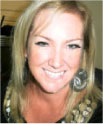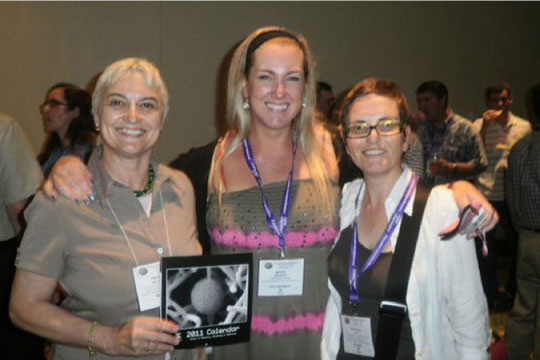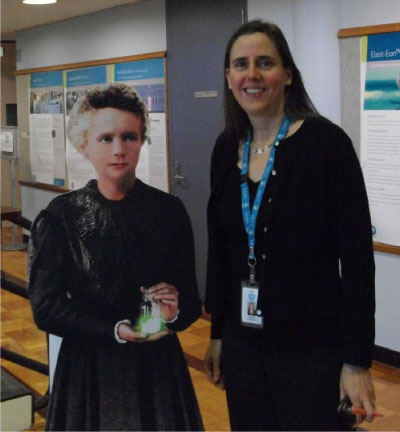Women in Chemistry
Jennifer M. Bennett AA CSIRO PUBLISHING, PO Box 1139, 150 Oxford Street, Collingwood, Vic. 3066, Australia.

Jenny Bennett was born in the UK in 1968, and graduated from the University of Melbourne with a Ph.D. (synthesis and biological activities of analogues of compounds with anti-cancer properties). Since 1995 she has worked as Assistant Editor, Associate Editor, Production Editor, and Deputy Managing Editor of Australian Journal of Chemistry – an International Journal for Chemical Science and Environmental Chemistry. She was heavily involved in launching the CSIRO suite of journals in electronic form in 1997. Since 2008 she has been Publisher of the chemical sciences journals within CSIRO PUBLISHING. She is grateful to have a job which allows her to interact with so many remarkable scientists. |
Australian Journal of Chemistry 64(6) 659-660 https://doi.org/10.1071/CH11255
Published: 27 June 2011
You will have heard it many times – 2011 is the International Year of Chemistry. It marks a worldwide celebration of the achievements of chemistry and its contributions to the well being of humankind. The year 2011 also coincides with the 100th anniversary of the Nobel Prize in Chemistry being awarded to Madame Marie Curie, and is a fitting opportunity to celebrate the contributions of women to science.
It is therefore with much pride, and with great pleasure, that I introduce this special edition of Australian Journal of Chemistry – an International Journal for Chemical Science dedicated to Women in Chemistry. The concept of this issue emerged at the 237th ACS National Meeting held in Salt Lake City in March 2009. Faced with an ocean of unfamiliar faces, I was delighted to see Frances Separovic’s friendly smile from across the room. Professor Separovic (Fig. 1) is internationally known for her research on NMR and structural studies of membrane peptides. Apart from her talents as a scientist, she is entertaining and lively company, and within several hours we were lunching together. During this time, an idea of showcasing the unique talents of Australian and New Zealand female chemists began to take shape, and within an hour we had produced a two-page list of potential candidates. With her enthusiasm and commitment, she was the right and proper choice as Guest Editor for this special issue.

|
Due to page constraints, we were not able to invite everyone on that list; many exceptionally talented chemists did not contribute to this special issue. Our ultimate aim was to represent some of our most eminent women scientists while providing a breadth of subject areas and a broad cross-section of academic institutions within Australia and New Zealand. Of the scientists approached, almost everyone was enthused about the idea and nearly all agreed to contribute.
2011 is indeed a year to celebrate the progress that has been made in promoting the rights of women. In 1992, just 16 women out of 483 chemistry academics were employed in Australia. By 1995, this number had almost doubled. From two female professors of chemistry in 2000, there are now more than a dozen, and outstanding women chemists are now leading research groups and university faculties and departments. There are also now significant numbers of women who hold senior executive positions within universities and in the private sector. Having outlined how far women have come, it is also a time to remember and honour the struggle that many of our older female colleagues have made in paving the way for a smoother course for the younger ones amongst us. In a recent interview, Australia’s Governor General Quentin Bryce was asked if she was proof that women could have it all – careers, family, love, and health – she replied ‘women can have it all, but not at the same time!’ There are women who struggle with the choice about whether to have a family or strive for success in their career. We need to ensure mechanisms are in place to allow the flexibility for women to freely choose family and career at different times.
This issue contains a diverse selection of research papers, as well as several thought-provoking essays. One such piece,[ 1 ] by Margaret Sheil, CEO of the Australian Research Council, outlines the scarcity of women in chemistry, particularly in the ranks of leadership of academic chemistry. In fact, the Royal Australian Chemical Institute (RACI), the main professional association of chemists in Australia, has only had one female national president, Doreen Clark, in 1994. This noticeable lack of female role models is not confined to Australia. Prior to 2009, when Israeli chemist Ada Yonath was awarded the Nobel Prize for Chemistry, the last female chemist to be awarded a Nobel Prize was Dorothy Hodgkin in 1964. These two chemists, along with Marie and Irène Curie, comprise the entire quota of women chemists to be honoured in this way. I do hope you enjoy reading this piece, as well as the many other excellent papers contained in this edition.
In keeping with the Women in Chemistry theme, in January I was pleased to attend the ‘Women Sharing a Chemical Moment in Time’ networking breakfast, held at CSIRO Materials Science and Engineering, Clayton (Fig. 2). Women from 37 countries simultaneously held a series of events under this banner. This occasion was held to support and promote women in chemistry before the launch of the International Year of Chemistry, and over 90 women in the Melbourne area attended. From this event, the ‘Women in Chemistry (WINC)’ group in Melbourne was convened. A subsequent WINC afternoon networking event was held on International Women’s Day (8 March) at the city offices of Phillips Ormonde Fitzpatrick, Melbourne. Borne from these events was the WINC website (www.womeninchemistry.com). Given the current level of interest and support, the WINC group looks set for a bright and exciting future.

|
References
[1] M. M. Shiel, Aust. J. Chem. 2011, 64, 661.| Crossref | GoogleScholarGoogle Scholar |


